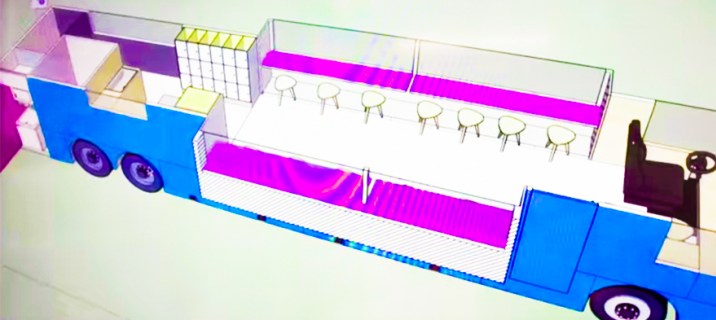A few weeks ago, XQ: The Super School Project, announced 10 winners, each receiving $10 million, for its high-school reinvention competition. One winner will turn a museum into a school, another is located on a barge.
But one winner is notable not for having an unusual location or snazzy course offerings but for the students it serves, homeless and foster youth, often the most forgotten kids in the system.
RISE High, a charter school in Los Angeles, will share three or four sites with existing nonprofits that offer services such as medical and mental health care, meals, legal assistance, and arts programs.
In addition, RISE will have an online learning hub and a mobile learning center housed in a bus to transport students to and from classes, and provide them with computers, Wi-Fi, hygiene products, a washer/dryer, homework assistance, tutors, and therapists.
RISE co-founder and assistant principal Erin Whalen said homeless and foster youth often feel discouraged by the lack of institutional support:
“The system doesn’t always work for them. The system is not always there to support them. They’ve internalized ideas that this is where they’re at and this is where they’ll always be. School can be a force to counteract that.”
For these transient groups of students, a school like RISE High is long overdue.
SOBERING NUMBERS
There are over 526,000 homeless children in California—approximately a fifth of the nation’s 2.5 million total—and the number increases every year. California also has over 43,000 foster children. In both cases, the Los Angeles Unified School District (LAUSD) educates the state’s highest share of these subgroups: over 15,000 homeless students and 7,500 foster youth.
Data on the educational achievement of homeless students is scarce, but if they’re anything like the findings available for foster children, they’re sobering.
A 2015 report found that students in foster care face more obstacles when compared to other at-risk children in California:
- While the statewide high-school graduation rate is 84 percent, the number plunges to 58 percent for foster youth. They have the highest dropout rate and the lowest graduation rate.
- A much greater proportion of foster youth attend the state’s lowest-performing schools compared to students throughout the rest of the state.
- Foster youth are twice as likely to be eligible for special education services.
- Foster youth are four times more likely to change schools at least once during the school year.
- Children in foster care are more likely to attend nontraditional schools.
MORE MUST BE DONE
Schools have been slow to recognize the challenges these students grapple with. The report states:
A growing research literature has begun to make the case that students in foster care are especially at risk for school failure, as evidenced by poor grades and high rates of absenteeism, grade retention, disciplinary referrals, and dropping out of high school. Yet the message that students in foster care constitute a distinct subgroup of at-risk students has not yet been clearly or fully translated from research to policy to practice.
This unclear translation has been evident in the implementation of the Local Control Funding Formula (LCFF), which gives districts extra money for low-income children, English-language learners, and foster and homeless youth.
The Los Angeles Unified School District waged an unsuccessful appeal of a $450 million lawsuit for not spending LCFF money in the spirit of the law. LAUSD’s defense was that spending on other groups of students, such as those in special education, met the requirement.
FOSTER AND HOMELESS YOUTH REQUIRE MORE THAN WHAT TRADITIONAL PUBLIC SCHOOLS ARE ABLE TO GIVE THEM
Foster and homeless youth require more than what traditional public schools are able to give them and this fact underscores RISE High’s potential as a pioneer in remaking how we educate these students.
RISE High focuses on the unique circumstances of these overlooked students, understanding that a traditional brick-and-mortar operation is ill-suited to their tumultuous lives. It doesn’t just accommodate homeless and foster kids, but tailors everything it does around these students.
It is a powerful example of a school designed to meet the needs of its students, not the other way around. If we are to rethink high school, we must expand our notions of its purpose and even what it looks like.
RISE High fulfills the promise of school choice as originally envisioned, schools whose flexibility can better serve students in ways traditional public schools cannot—flexible enough to travel on a bus.
Original crossposted from Ed Post:
One High School’s Plan to Bring School to the Most Overlooked Students
Caroline Bermudez
A proud graduate of Chicago Public Schools, she has a B.A. in history from Swarthmore College.
Latest posts by Caroline Bermudez (see all)
- La Absurdidad en la Omisión de Escuelas Charter en Los Angeles - November 6, 2016
- The Absurdity of Charter School Oversight in LA - November 6, 2016
- One High School’s Plan to Bring School to the Most Overlooked Students - October 26, 2016
- El Plan de Una Escuela Preparatoria Para Traer Escuela a los Estudiantes Que Más Se Pasan Por Alto - October 26, 2016
- See Why These Kids and Teachers in San Diego Are Screaming in Celebration - October 21, 2016

